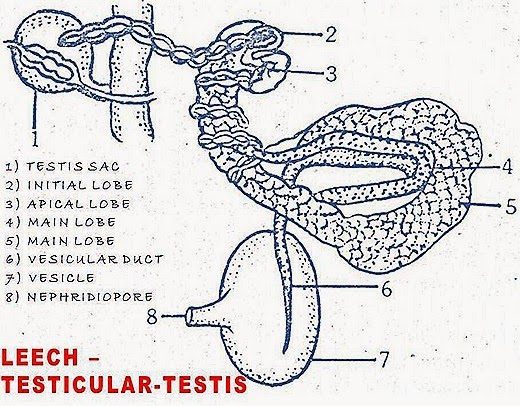HIRUDINARIA-EXCRETORY SYSTEM-NEPHRIDIUM STRUCTURE FUNCTION
In HIRUDINARIA the excretory system includes 17 pairs of Nephridia. They are arranged in 6th to 22nd segments, one pair in each segment. In these 17 pairs the first six pairs will not show contact with testis. They are called pre-testicular nephridia. The next 11 pairs of nephridia will show contact with testis, hence they are called testicular nephridia.
Structure of Testicular Nephridium:
Each nephridium contains six regions.
1) Main lobe
2) Vesicle
3) Apical lobe
4) Inner lobe
5) Initial lobe
6) Ciliated organ.
1) Main lobe: It is the bigger part of the nephridium. It is present in between two adjacent crop caecae. It has short posterior and long anterior limbs. They are free in the median axis. They are used externally. It looks like a horse shoe.
2) Vesicle : It is a thin walled large chamber. It shows inner ciliated epithelium. It is present behind the main lobe. It gets a vesicle duct from the ventral end of the anterior limb of the main lobe.
This vesicle takes up storage of excretory wastes.- It gives a small duct called excretory duct. It opens out through the nephridiopore.
In leech 17 pairs of nephridiopores are present on the ventral side, from 6uS to 22nd segments, one pair in the last annulus of each segment.

3) Apical lobe: The posterior limb of main lobe will form an apical lobe. Its anterior end is swollen.
4) Inner lobe: It is thin. It lies all along the concavity of main lobe. It extends out of the apical lobe.
5) Initial lobe: It is long. It is coiled around the apical lobe. It is the testis-lobe. It joins with the anterior limb of the main lobe. Anteriorly it extends towards the testis sac and ends there near the peri nephrostomial ampullae.
6) Ciliated organ: It contains two parts a) Central reservoir and b) many ciliated funnels.
The reservoir is made by single celled thick layer. This layer shows a number of openings. In these openings funnels are arranged. The neck of the funnel enters the pore. The broader parts of these funnels are closely approximated and cover the reservoir. These funnels show cilia.
This ciliated organ is present in the peri nephrostomial ampullae. In the embryo it is connected with the nephridium by cellular cord and takes up excretory function. But in adults it has no connection with the nephridium. It plays a role in the haemocoelomic system.
Pre-testicular Nephridia :
These are 6 pairs. They are present in 6th to 11th segments. They are not associated with testis. They resemble the testicular nephridia in all ways, but these pre-testicular nephridia will not show peri-nephrostomial ampullae and ciliated organs.
Process of Excretion:
1) A nephridium is supplied with haemocoelomic fluid. The nephridia will remove the nitrogenous wastes of haemocoelomic fluid. It absorbs, more
ammonia, small quantity of urea and other substances.
2) Nephridium can also absorb excess of water from the body.
These wastes are finally reach the vesicle and are sent out through the nephridiopore.
